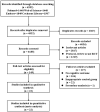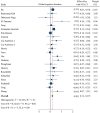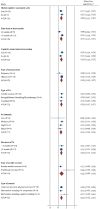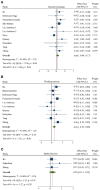Effect of Physical Activity on Cognitive Impairment in Patients With Cerebrovascular Diseases: A Systematic Review and Meta-Analysis
- PMID: 35599737
- PMCID: PMC9120585
- DOI: 10.3389/fneur.2022.854158
Effect of Physical Activity on Cognitive Impairment in Patients With Cerebrovascular Diseases: A Systematic Review and Meta-Analysis
Abstract
Background and purpose: This study investigates the effect of physical activity (PA) on cognition in patients with cerebrovascular disease and explored the maximum benefit of different PA characteristics.
Methods: Databases, such as Pubmed, Web of Science, Embase, and Cochrane Library, were searched from their inception to May 31, 2021. Standardized mean difference (SMD) and 95% confidence intervals (CIs) were calculated to generate a forest plot. In addition, subgroup analysis, moderation analysis, and regression analysis were performed to explore the possible adjustment factors.
Results: In total, 22 studies that met the criteria were included, demonstrating data from 1,601 participants. The results indicated that PA produced a positive effect on the global cognition for patients with cerebrovascular disease (SMD: 0.20 [95% CI: 0.12-0.27]), at the same time, PA training prominently improved executive function (SMD: 0.09 [95% CI: 0.00-0.17]) and working memory (SMD: 0.25 [95% CI: 0.10-0.40]). Furthermore, patients with baseline cognitive impairment received the greater benefit of PA on cognition (SMD: 0.24 [95% CI: 0.14-0.34]) than those without cognitive impairment before intervention (SMD: 0.15 [95% CI: 0.04-0.26]). For patients in the acute stage (≤ 3 months), PA did not rescue impairment dysfunction significantly (SMD: 0.08 [95% CI: -0.04-0.21]) and remarkable cognitive gains were detected in the chronic stage of participants (>3 months) (SMD: 0.25 [95% CI: 0.16-0.35]). Moderate intensity PA showed a larger pooled effect size (SMD: 0.23 [95% CI: 0.11-0.36]) than low intensity (SMD: -0.01 [95% CI: -0.44-0.43]) and high intensity (SMD: 0.16 [95% CI: 0.03-0.29]). However, the different types, duration, and frequency of PA resulted in no differences in the improvement of cognitive function. Further regression analysis demonstrated that the beneficial effects of PA on cognition are negatively correlated with age (p < 0.05).
Conclusions: This study revealed that PA can prominently improve the cognitive ability in patients with cerebrovascular diseases and strengthened the evidence that PA held promise as a widely accessible and effective non-drug therapy for vascular cognitive impairment (VCI).
Keywords: cerebrovascular disease; cognitive function; meta-analysis; physical activity; stroke; systematic review; vascular cognitive impairment.
Copyright © 2022 Lin, Liu, Dai, Yin, Li, Yang, Tao, Liu and Chen.
Conflict of interest statement
The authors declare that the research was conducted in the absence of any commercial or financial relationships that could be construed as a potential conflict of interest.
Figures






Similar articles
-
The influence of exercise interventions on cognitive functions in patients with amnestic mild cognitive impairment: A systematic review and meta-analysis.Front Public Health. 2022 Nov 15;10:1046841. doi: 10.3389/fpubh.2022.1046841. eCollection 2022. Front Public Health. 2022. PMID: 36457329 Free PMC article.
-
Effects of physical activity interventions on cognitive performance of overweight or obese children and adolescents: a systematic review and meta-analysis.Pediatr Res. 2021 Jan;89(1):46-53. doi: 10.1038/s41390-020-0941-3. Epub 2020 May 10. Pediatr Res. 2021. PMID: 32388536
-
Effect of cognitive training on patients with breast cancer reporting cognitive changes: a systematic review and meta-analysis.BMJ Open. 2023 Jan 2;13(1):e058088. doi: 10.1136/bmjopen-2021-058088. BMJ Open. 2023. PMID: 36592995 Free PMC article.
-
Effects of physical exercise on cognitive function of older adults with mild cognitive impairment: A systematic review and meta-analysis.Arch Gerontol Geriatr. 2020 Jul-Aug;89:104048. doi: 10.1016/j.archger.2020.104048. Epub 2020 May 12. Arch Gerontol Geriatr. 2020. PMID: 32460123
-
Effects of excitatory transcranial magnetic stimulation over the different cerebral hemispheres dorsolateral prefrontal cortex for post-stroke cognitive impairment: a systematic review and meta-analysis.Front Neurosci. 2023 May 16;17:1102311. doi: 10.3389/fnins.2023.1102311. eCollection 2023. Front Neurosci. 2023. PMID: 37260845 Free PMC article.
Cited by
-
Association between exercise habit changes and incident dementia after ischemic stroke.Sci Rep. 2023 Mar 9;13(1):3959. doi: 10.1038/s41598-023-31229-z. Sci Rep. 2023. PMID: 36894695 Free PMC article.
-
The effect of physical exercise and cognition-orientated interventions on post-stroke cognitive function: Protocol for an overview of reviews.PLoS One. 2025 Jan 29;20(1):e0318567. doi: 10.1371/journal.pone.0318567. eCollection 2025. PLoS One. 2025. PMID: 39879170 Free PMC article.
-
Muscle-Derived Small Extracellular Vesicles Mediate Exercise-Induced Cognitive Protection in Chronic Cerebral Hypoperfusion.Adv Sci (Weinh). 2025 Jul;12(27):e2410209. doi: 10.1002/advs.202410209. Epub 2025 Apr 24. Adv Sci (Weinh). 2025. PMID: 40271743 Free PMC article.
-
Pilot study examining the relationship between retinal vasculature and cognition in older adults recently discharged from a 12-week cardiac rehabilitation program.Ther Adv Ophthalmol. 2025 May 19;17:25158414251340541. doi: 10.1177/25158414251340541. eCollection 2025 Jan-Dec. Ther Adv Ophthalmol. 2025. PMID: 40395967 Free PMC article.
References
-
- Gorelick PB, Scuteri A, Black SE, Decarli C, Greenberg SM, Iadecola C, et al. . Vascular contributions to cognitive impairment and dementia: a statement for healthcare professionals from the american heart association/american stroke association. Stroke. (2011) 42:2672–713. 10.1161/STR.0b013e3182299496 - DOI - PMC - PubMed
Publication types
LinkOut - more resources
Full Text Sources
Miscellaneous

